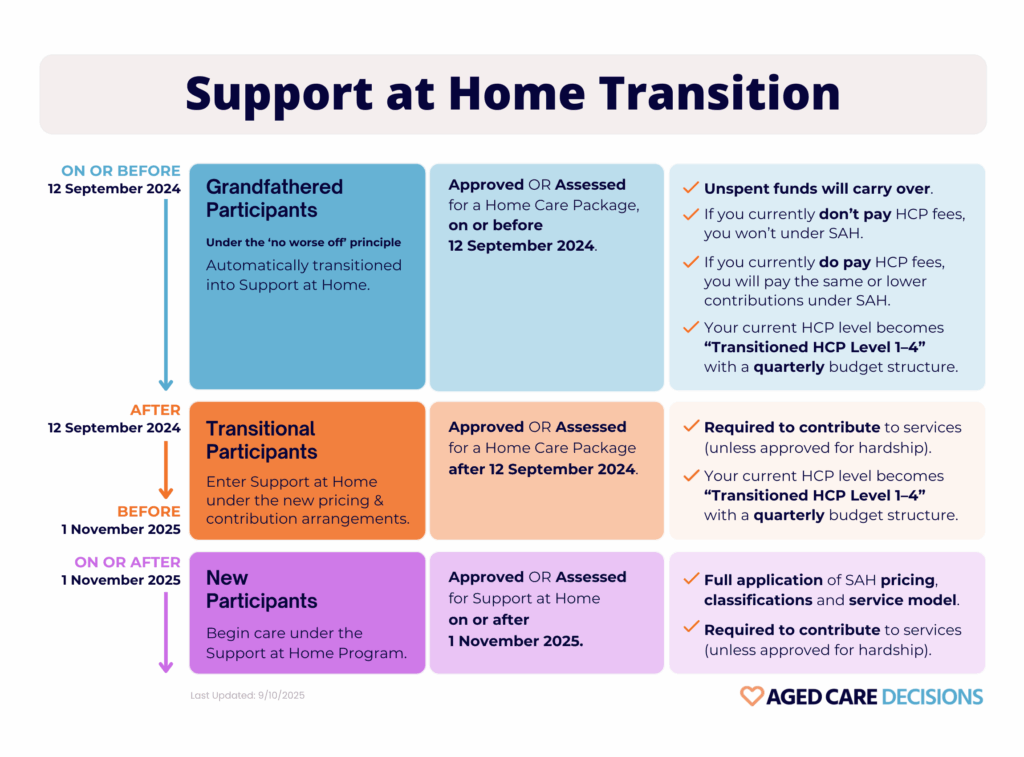When it comes to receiving care and support services at home, many people are unsure where they fit within the system. The terms can be confusing: new participant to home care, transitional participant, grandfathered participant, but understanding your category is important. It determines how services are provided, what funding might be available, and what level of flexibility you may have.
Whether you are just starting out with in-home support or have been receiving care for years, knowing your place within Support at Home helps you make informed choices and ensures that your needs are met.

This article breaks down these categories in detail, explains why they matter, and guides you through figuring out where you fit within the Support at Home framework.
Why “Support at Home” Matters
Support at Home is designed to help people remain independent, comfortable, and safe while living in their own homes. Rather than moving into a facility or relying entirely on family caregivers, clients can receive assistance tailored to their needs. Support at Home may include:
- Personal care: help with bathing, dressing, grooming, or toileting.
- Domestic support: cleaning, meal preparation, laundry, or grocery shopping.
- Health-related support: medication reminders, mobility assistance, or escorting to appointments.
- Companionship and social support: friendly visits, conversation, or activities to reduce isolation.
Because everyone’s situation is unique, Support at Home uses categories to identify where someone belongs within the system. Each category comes with different expectations and processes.
The Three Main Categories of Participants

1. New Participants to Home Care / Support at Home
If you are seeking help for the first time, you are considered new to home care. This group includes people who:
- Have recently experienced a change in health (e.g., surgery, illness, or decline in mobility).
- Have reached an age or stage in life where daily tasks have become more difficult.
- No longer want to rely solely on family or friends for support.
- Have never accessed Support at Home or Home Care Packages
- Have never received an Aged Care Assessment from MyAgedCare before
What it means to be new to home care:
- You will usually go through an intake process. A coordinator or assessor meets with you to determine your needs, preferences, and eligibility.
- Services may start slowly and then increase or decrease as your situation changes.
- You will be introduced to the funding system, whether through government programs, private pay, or a combination.
- You will receive information about how to request changes or additional services in the future.
For someone new, the experience can feel overwhelming. There are forms to complete, new people coming into your home, and adjustments to daily routines. However, this stage also comes with opportunities, and you get to shape your care from the beginning, setting expectations with your care team.
2. Transitional Participants
A transitional participant is someone moving from one type of service or funding arrangement to another. For example:
- Moving from a hospital stay or rehabilitation program into home-based support.
- Transitioning from an older funding model into a new Support at Home framework.
- Shifting from informal family support to more formal, structured home care.
What it means to be a transitional participant:
- You may already have some services in place through the Commonwealth Home Support Program and your Home Care Package, but the services need to be upgraded.
- There may be temporary overlap between programs (e.g., hospital discharge services alongside new home support).
- You might experience changes in eligibility criteria or funding rules, which can sometimes mean fewer or different services.
- Communication becomes key. Transition clients often need to clarify roles between old providers and new ones.
Transitions can be both challenging and reassuring. On one hand, change can cause stress and uncertainty; on the other, it provides a chance to reassess your needs and improve your support system.
Start comparing providers rightaway with a tailored report sent to you within 20 minutes. Get started here.
3. Grandfathered Participants
A grandfathered participant is someone who began receiving services before 12 September 2024 and has been allowed to continue under those same terms, even though new clients may follow different rules. For example:
- You may have started receiving home support when certain tasks (like heavy cleaning or yard work) were included, and you are still allowed to receive them, even though new clients cannot.
- You might pay different rates or have access to programs that are no longer open to new applicants.
- You may be protected from some of the changes in newer policies.
What it means to be a grandfathered participant:
- Your care package may look different from what new clients receive.
- You may not need to reapply for funding or eligibility under the new framework.
- You often have more stability, since your services continue as originally agreed.
- However, you may face confusion when comparing your services to those of neighbours, friends, or family who are new clients.
Being a grandfathered client can feel like an advantage, but it is important to stay informed. Policies sometimes shift, and while grandfathered rights are usually respected, there can be exceptions.
How to Determine Where You Fit
If you are unsure whether you are new, transitioning, or grandfathered, consider the following questions:
- Am I starting services for the very first time? If yes, you are new to home care.
- Am I moving from one program or system into another? If yes, you are a transition client.
- Have I been receiving services before 12 September 2024 under rules that no longer apply to new clients? If yes, you are a grandfathered client.
If you are still unsure, speak with your care coordinator or one of our team to clarify your category and explain how it affects your care.
Why It Matters Where You Fit
Understanding your category is not just about labels. It impacts real aspects of your life:
- Services available: What you qualify for can depend on your category.
- Expectations: Care workers and agencies use your category to guide how they deliver support.
- Planning for the future: Knowing where you fit helps you anticipate changes, whether in health needs or program rules.
Tips for Making the Most of Support at Home
No matter your category, here are some ways to get the best experience:
- Ask questions early: Don’t wait until you are struggling. Clarify what is included, who pays, and how to make changes.
- Build relationships with care workers: A strong partnership creates trust and smoother service delivery.
- Keep records: Track appointments, hours of service, and changes in care plans.
- Stay flexible: Needs change, and so should your support.
- Advocate for yourself: If something isn’t working, speak up. Your voice is central to your care.
Support at Home is about more than services. It’s about independence, dignity, and quality of life. Whether you are new to home care, a transition client, or a grandfathered client, you play an active role in shaping your experience.
Finding out where you fit is the first step. From there, you can navigate the system with greater confidence, understand your rights and options, and make choices that support your unique needs. By knowing your category and staying engaged, you ensure that Support at Home truly works for you.
Aged Care Decisions helps you understand where you fit within Support at Home and connects you with the right providers to make the most of it. Whether you’re new to home care, moving through a transition, or a grandfathered client, we make sure you’re supported every step of the way.
✔ Find providers who understand your category and needs.
✔ Compare local home care services tailored to your situation.
✔ Save time; no endless calls or confusing paperwork.
✔ Get expert, FREE guidance on your options and next steps.
Our service is fast, FREE, independent and tailored to your unique needs. Let us know what you want and we’ll send you a report within 20 minutes.
Here’s how our FREE service works:







